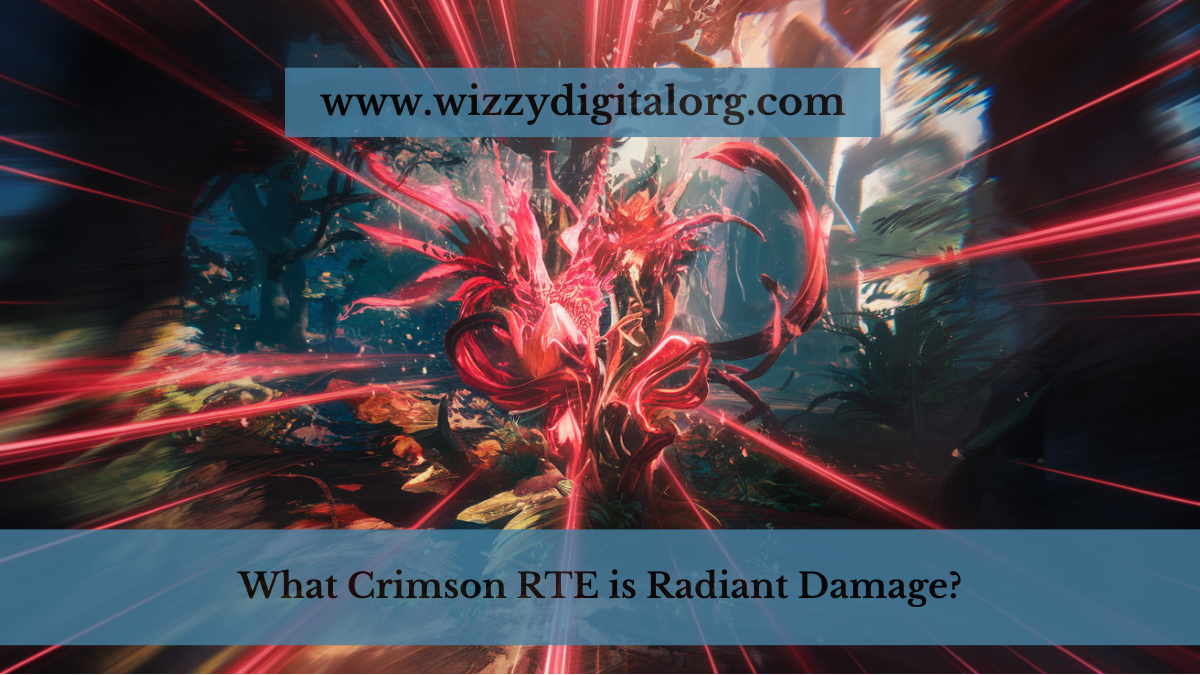What Crimson RTE is Radiant Damage?
In the expansive realms of fantasy storytelling, gaming, and role-playing, the concept of Crimson RTE radiant damage holds unique allure. This term intricately blends the idea of crimson energy—a representation of vitality, life, or raw power—with radiant energy, characterized by luminous light that purifies or harms in its brilliance. For enthusiasts of high-fantasy adventures and RPG mechanics, understanding this term can enhance gameplay, storytelling, and creative endeavors.
Crimson RTE radiant damage refers to energy from crimson sources transformed into radiant light, combining vitality with luminous force, often seen in fantasy or role-playing settings.
This comprehensive guide explores the concept of what crimson RTE is radiant damage, including its origins, significance, mechanics in gaming, and broader implications. Whether you’re a Dungeon Master crafting your next campaign or a curious player delving into the lore of radiant damage, this article will illuminate the fascinating topic.
1. What is Crimson RTE?
The term Crimson RTE symbolizes crimson energy, a powerful force often associated with life, vitality, and raw magical energy. In various fantasy settings, crimson energy might represent:
- Blood Magic: Derived from life essence, offering immense power at great cost.
- Life Force: An elemental source representing vitality, health, and endurance.
- Mystical Fire: Crimson flames that symbolize destruction and rebirth.
Crimson RTE forms a foundation for imaginative storytelling, blending emotion, power, and transformative magic.
2. Understanding Radiant Damage
Radiant damage is a hallmark of many fantasy systems, symbolizing light’s power to heal, purify, or destroy. Common attributes of radiant damage include:
- Holy or Divine Energy: Often linked to gods, celestial beings, or sacred magic.
- Purification: Effective against undead, demons, and dark forces.
- Brilliant Light: Causes searing pain to creatures vulnerable to sunlight or brightness.
Radiant damage is both offensive and defensive, representing purity’s triumph over darkness.
3. How Crimson Energy Becomes Radiant Damage
The transformation of crimson energy into radiant damage occurs through unique mechanisms in fantasy lore. Some interpretations include:
- Divine Infusion: Crimson energy, blessed by celestial forces, transforms into radiant light.
- Life to Light Conversion: Vital energy turns into luminous force, merging physical strength with spiritual brilliance.
- Arcane Alchemy: Advanced magic that channels raw crimson power into radiant destruction.
This combination underscores themes of sacrifice, transformation, and cosmic balance.
4. Origins and Lore of Radiant Damage in Fantasy Settings
Radiant damage frequently appears in mythology, fantasy novels, and RPG systems. Its origins often tie to ancient gods or cosmic events. For example:
- Dungeons & Dragons (D&D): Radiant damage is wielded by clerics and paladins, often associated with holy light.
- Fantasy Novels: Luminous energy often manifests as a protagonist’s ultimate power.
- Mythological Connections: Stories of gods like Apollo or Ra, representing the sun, align with radiant themes.
Crimson energy as a source of radiant damage reflects innovation in blending traditional tropes with novel ideas.
5. Crimson RTE Radiant Damage in Popular Games
In role-playing games and fantasy franchises, Crimson RTE radiant damage often features as a mechanic or thematic element. Some examples include:
- Dungeons & Dragons: Radiant damage spells like Sacred Flame or Sunburst could originate from crimson energy sources.
- Pathfinder: Crimson energy might power divine magic or holy relics.
- Video Games: Titles like Dark Souls or Elden Ring explore crimson power and radiant light in their intricate lore.
By leveraging both crimson energy and radiant damage, creators add depth to their worlds.
6. Mechanics of Crimson RTE Radiant Damage in RPGs
In tabletop RPGs, radiant damage mechanics are central to gameplay. Here’s how it works:
- Damage Type: Radiant damage is effective against undead, fiends, and shadow creatures.
- Spellcasting: Magic spells channel crimson energy into radiant attacks, such as searing beams or holy blasts.
- Weapons: Some enchanted weapons convert physical strikes into radiant damage, boosted by crimson energy.
Gamers often strategize around radiant damage’s unique properties, particularly its effectiveness against dark enemies.
7. Symbolism and Themes Behind Radiant Damage
Radiant damage carries profound symbolic weight. It signifies:
- Purity vs. Corruption: Light banishing darkness is a universal theme.
- Sacrifice: Crimson energy’s transformation often implies selflessness.
- Cosmic Duality: Balancing raw vitality with divine purpose enriches storytelling.
8. Practical Uses in Game Design and Storytelling
Game masters and writers can creatively implement Crimson RTE radiant damage through:
- Character Backstories: Tie a hero’s crimson energy to their divine mission.
- Worldbuilding: Develop lore explaining radiant damage’s origin.
- Combat Scenarios: Introduce enemies vulnerable to radiant damage for exciting battles.
FAQs
Q1. What creatures are weak to radiant damage?
Radiant damage is highly effective against undead, fiends, and shadowy entities vulnerable to light.
Q2. Can crimson energy heal instead of harm?
Yes, crimson energy can support healing spells when converted into radiant energy.
Q3. Is radiant damage common in all RPG systems?
Many systems feature radiant damage, though mechanics vary between games.
Q4. How does radiant damage affect gameplay balance?
Radiant damage introduces strategic depth, countering powerful dark-aligned enemies.
Q5. Can crimson energy exist without transformation?
Absolutely! Crimson energy can remain raw, representing vitality or untamed power.






